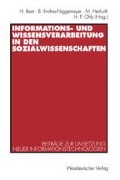Abstract
Throughout their history, social science data archives concentrated on a direct, unambiguous goal. They retained computerised information (data) files for distribution to secondary analysts. While archivists will not shrink from describing the difficulties still entailed in this aim, their success minimised general awareness of their efforts.
This contribution is an elaborated version of a paper presented at the Dokumentartag in Bremen.
Access this chapter
Tax calculation will be finalised at checkout
Purchases are for personal use only
Preview
Unable to display preview. Download preview PDF.
Literatur
This contribution is an elaborated version of a paper presented at the Dokumentartag in Bremen.
Tanenbaum, E., 1986: “Archives and Dinosaurs” ‘ASSIST Journal iv:; and Tanenbaum, E. and M. Taylor, 1991: “Developing Social Science Data Archives”, International Social Science Journal xliii: 225–234.
eg local mass storage devices, inter-computer networking, database systems with common user interfaces. One Archive’s adjustment to these changes is described in Tanenbaum, E., 1992: “A Quarter Century of Archiving”, Government Computing vi, 7: 6–7.
The most recent instances being data archives in Switzerland, New Zealand and Poland.
Although established in 1967, it had a two year lead-in period before it distributed data.
eg growth in (a) social science community, (b) acceptance of empirical research, (c) access to computers, and (d) quantitative skills.
FES: Family Expenditure Survey, GHS: General Household Survey, LFS: Labour Force Survey, and BES: British Election Surveys.
Cattell, R. B., 1978: The Scientific Use of Factor Analysis in Behavioral and Life Sciences ( London: Plenum Press).
For example, my first analysis encounter with the Family Expenditure Survey used a ten year slice which meant a dataset with 250.000 observations. Although I had grown to love asterisks in psychology research reports, I was less enthusiastic when my standard computer package insisted in producing rows of asterisks in all the output I generated. The mass of data threw it into overflow fits as it tried to calculate simple variances across a quarter million observations
For example, the researcher interested in authoritarianism may feel foolish asking respondents to evaluate “zoot-suiters” but might still want to tap ethnocentrism with a more contemporary, but subjectively-equivalent, stimulus.
It may also be that many analysts of multi-year datasets are risk-takers. It is surprising how many request several years’ data from a survey set based on reading the documentation for a single year.
It might be thougt that most, if not all, of these concerns should be covered in the documentation that accompanies the data themselves. However this solution is more easily recommended than achived, if only because the documentation should include the experiences of secondary analysts who will often focus on aspects of the data unexplored by the primary investigators. Related issues are discussed in Martin, D., 1991: “The Science of Data Sharing: Documentation” in: Sieber, J. (ed.): Sharing Social Science Data (London: Sage), p. 91–115; and Sieber, J., 1991: “Social Scientist Concern About Sharing Data” in Sieber, J. (ed.), ibid., p. 141–150.
Because disciplines are identified by the user’s departmental address, this is at best a rough approximation to what researcher affiliations are. For example, political scientists are defined as those users whose departmental address contained one of the following character strings: POL, INTER (for international relations), PEACE (peace studies), GOV (government) or PUB (public administration).
Even application fields, which often transcend disciplinary boundaries, offer an inadequate spread of contacts. Appendix A lists a set of research projects undertaken in one year with one of these data series. It can be seen that the applications are almost as diverse as the researchers’ professional orientations.
Although it would be nice to think that the Archive is iterating toward the perfect solution for knowledge interchange one frequently suspects that we are simply fixed in a local minima.
Indeed in the beginning it was also possible to offer travel support to all attenders; this is now only available to people on Research Council studentships.
The venues are only announced to those who return them.
Although dated, the December 1985 issue of BYTE (vol X,13) features on computer conferencing shows the genesis of our enthusiasm for this communication technology. The articles by Jacob Palme (“Conferencing Standards” and “Database Structure in PortaCom”) are of particular interest in the context of the Archive’s Bulletin Board as we adopted Palme’s COM for its conferencing system.
Joint Academic NETwork.
Internet makes communication across computer networks possible. Two services that it supports that are particularly relevant to social researchers are ARCHIE (archive information enquiries) and WAIS (wide area information service). Both offer global information searches. For accessible overviews of these facilities see Dern, D., 1992: “Applying the Internet” in Byte xvii, 2: 111–118; Stein, R, 1991: “Browsing Through Terabytes” in Byte xvi, 5: 157–164; and Kehoe, P., 1992: “Zen and the Art of the Internet” which is widely available from different Internet hosts. More information about these is also available in the Spring 1992 issue of Electronic Networking: Research, Applications and Policy ii, 1. A somewhat older, but still appropriate review is Quarterman, J., 1989: “The Matrix: Computer Networks and Conferencing Systems Worldwide” ( Bedford: Digital Press).
Editor information
Editors and Affiliations
Rights and permissions
Copyright information
© 1994 Westdeutscher Verlag GmbH, Opladen
About this chapter
Cite this chapter
Tanenbaum, E. (1994). Sharing Information Demands Sharing Knowledge. In: Best, H., Endres-Niggemeyer, B., Herfurth, M., Ohly, H.P. (eds) Informations- und Wissensverarbeitung in den Sozialwissenschaften. VS Verlag für Sozialwissenschaften. https://doi.org/10.1007/978-3-322-93603-5_19
Download citation
DOI: https://doi.org/10.1007/978-3-322-93603-5_19
Publisher Name: VS Verlag für Sozialwissenschaften
Print ISBN: 978-3-531-12501-5
Online ISBN: 978-3-322-93603-5
eBook Packages: Springer Book Archive

